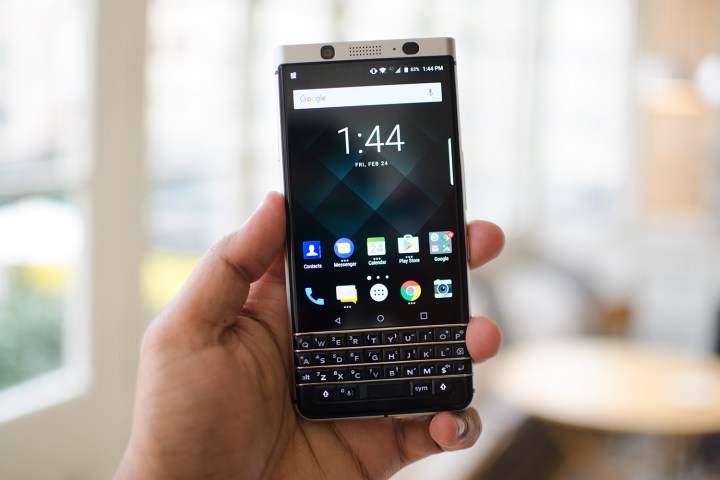
You might find the design bulky and perhaps a little outdated, but it’s a productivity powerhouse as we found in our BlackBerry KeyOne review. If you’re going to drop over $500 for a phone where the keyboard is the main attraction, you’ll want to be fully aware of all its functions. Here are 10 different features the QWERTY keyboard has to offer to make the experience worth your while.
Set short-press and long-press shortcuts
Each key on the keyboard can be assigned a function — whether it’s to a specific contact, an app, or sending an email. There are 52 unique keyboard shortcuts to choose from. You can also turn on short-press keyboard shortcuts by going to the BlackBerry Launcher settings and tapping Typing action > Use a short-press keyboard. To set long-press shortcuts, tap on Apps > Keyboard shortcuts to bring up a list of options to assign a long-press shortcut. The only difference between the two is that, for long-press, you press and hold the specific key to assign the shortcut. For example, you can assign the Google app to a short press of the “G” key, but a long-press can open Gmail.
Physical and touchscreen keyboards

Regardless of how much you love the physical keyboard, there could be days where you miss having a touch screen. The KeyOne has an option to include a keyboard on your touch screen. Add this feature by going to Language and Input > Physical Keyboard > Show Virtual Keyboard. The virtual keyboard will stay on the screen, even if you decide to switch to the physical keyboard. Keep in mind this will limit your screen real estate.
Statistics pertaining to your text-messaging activity
If you’re interested in learning about your activity on the keyboard, the KeyOne compiles real-time data based on your use. To access these statistics go to Keyboard Settings > BlackBerry Keyboard > Statistics. This shows you everything from how many words, emojis, and symbols you’ve typed, to how many times you used the touchscreen keyboard in comparison to the physical one.
Keyboard swiping and swipe gestures
While using the touchscreen keyboard, the “type by swiping” feature can be enabled through Keyboard Settings > BlackBerry Keyboard > Type by swiping. Type out words quickly by swiping from key to key without lifting your finger. For the physical keyboard, you can use the prediction bar above to help you type faster. Make sure it’s turned on by heading to Settings > Languages and input > Keyboard Settings > BlackBerry Keyboard > Prediction and Correction > Show predictions. When typing, you can flick your finger up on the left, center, and right side of the physical keyboard to quickly use one of the three options on the prediction bar.
Set up the fingerprint scanner
There are many different ways to make sure your Android device is secure, with a fingerprint scanner being one of them. While many Android phones have a fingerprint scanner positioned on the back of the phone, the KeyOne incorporates it into the space bar of the keyboard. You’ll have the option to set it up when you first turn on the phone, but if you choose to do it later, you’ll find it under Settings > Security > Fingerprint. That way, you can always unlock your phone by placing your finger on the space bar.
Accessing emojis

When you’re in the standard messaging window, accessing emojis isn’t as obvious as you’d think. By holding down the zero key, the library of emojis will instantly appear with tabs of different categories to choose from on the bottom. To turn on predictive emojis — emoji suggestions based on the text you type — tap on Keyboard Settings > BlackBerry Keyboard > Prediction and Correction > Predict Emojis. You then swipe up on the keyboard to insert the emoji into your text.
Swipe the keyboard to scroll in multiple directions
You may have assumed the physical keyboard was strictly for pressing buttons, but you’re also able to scroll with it. If you’re scrolling through an app like BlackBerry Hub — which consolidates all your emails, calendar events, tasks, and important notifications into one inbox — simply swipe up or down on the keyboard to keep viewing content. Swipe right or left to switch between the pages on your home screen, and delete words by swiping left if you’re typing out sentences.
Enable cursor control

Double tapping the keyboard enables cursor control. By swiping back and forth on the keyboard, you’ll move the cursor to the desired location when typing. If you don’t want to use the keyboard, there are arrow options on the touch screen you can tap on to move the cursor instead.
Set multiple language keyboards
To set up multiple keyboards in different language, go to Keyboard Settings > BlackBerry Keyboard > Multi Language Keyboards and then choose which language you wish to include by scrolling through the list. To switch between languages while typing, you can press and hold down on the space bar.
Keyboard sounds
Enabling sounds while typing is an option you can enable through Keyboard Settings > BlackBerry Keyboard > Key Press Feedback. You’ll have the option to turn the sound on — and choose the volume — as well as turn on “key pop-up” for the virtual keyboard to have the characters pop up while you’re typing.



